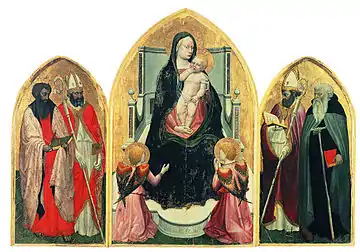San Giovenale Triptych
The San Giovenale Triptych is a 1422 painting by Italian Renaissance artist Masaccio, housed in the Masaccio Museum of Sacred Art at Cascia di Reggello, in the Metropolitan City of Florence. The triptych is the first work attributed to Masaccio and the earliest known painting essay using the geometric Renaissance perspective.
| San Giovenale Triptych | |
|---|---|
 | |
| Artist | Masaccio |
| Year | 1422 |
| Type | Tempera on wooden panels |
| Dimensions | 108 cm × 65 cm (42,51 in × 25,59 in) |
| Location | Masaccio Museum of Sacred Art, S. Pietro a Cascia di Reggello (FI) |
Description
The Triptych is a tempera on wooden panels (central panel 108 x 65 cm; two side panels 88 x 44 cm).
At the bottom of the panels, there are inscriptions in modern humanist letters for the first time in Europe not inscribed in Gothic characters:[1]
(ANNO DO)MINI MCCCCXXII A DI VENTITRE D'AP(RILE) - [April 23, 1422] - under the central panel
(PLE)NA DOMINUS. TECUM. BENEDICTA - on the throne step
and traces of the saints’ names on the side panels.
The central panel shows the Madonna enthroned with two angels and the child Jesus. The left panel depicts Saint Bartholomew and Saint Blaise, and the right panel depicts Saint Anthony Abbot and Saint Juvenal (Giovenale). The left and right panels show a marked influence of 14th-century models, while the center panel's complex perspective has been something new for its time. Also, the use of three-dimensional solidity makes the painting revolutionary for its time.
History
Masaccio painted the Triptych when he was twenty-one years old, probably commissioned by the family of Castellani or by that of Carnesecchi for the small church of San Giovenale, two kilometers from the Romanic Church at Cascia di Reggello. The presence on the painting of the eponymous Saint confirms its original location. Furthermore, the church is about 20 km from Castel San Giovanni in Altura (San Giovanni Valdarno), Masaccio’s birthplace.
The Triptych remained in San Giovenale Church for centuries until the re-discovering in 1961. The work was in a state of poor preservation, and the first who took care of it was the art historian Luciano Berti. After 27 years, meanwhile kept in the Superintendency’s storage areas, it was placed in the Romanesque church of San Pietro a Cascia and then, in 2002, in the Museum of Sacred Art.[2]
References
- http://www.museomasaccio.it/tryptich.html
- Rinascimento in Valdarno, a cura di Caterina Caneva, Edizioni Polistampa, 2007
External links
- Masaccio Museum of Sacred Art
- 600th anniversary website
- Piccoli Grandi Musei
- Masaccio Museum in Reggello
http://www.visitreggello-tuscany.com/cosa-vedere/museo-masaccio/